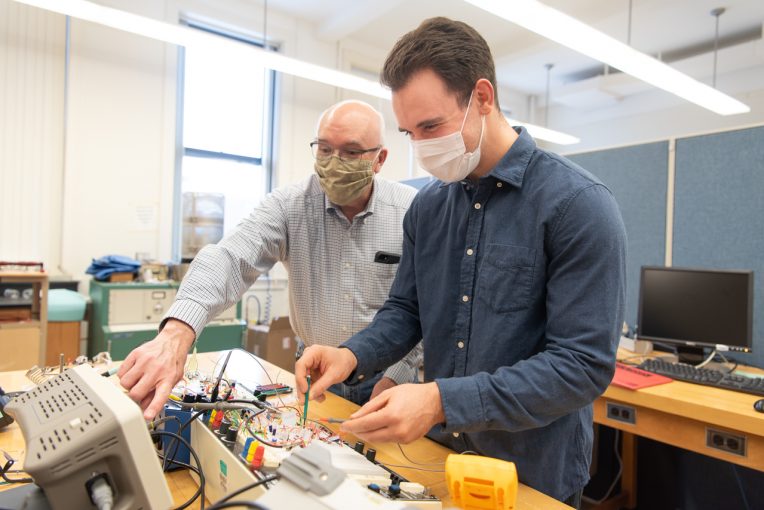Last November, a cross-disciplinary group of undergraduate students and faculty became the first Illinois State research team in 25 years to publish a paper in the American Journal of Physics (AJP). The journal is one of the most selective physics publications in the country, with an acceptance rate for reviewed articles hovering around 35 percent.
However, the group did not start off with their sights set on receiving recognition. The then-undergraduate physics student Zach Mobille ’19 conceived of the idea as he wrote a paper for his experimental physics course in fall 2018.
Appears InWhile enrolled in the course, Mobille became interested in the workings of single neurons. To better understand them, Mobille wanted to construct an electronic circuit for mimicking neuron behavior.
“I found some earlier work that had been done on this design, but it seemed kind of confusing,” said Mobille, who is now completing his master’s degree in mathematics at Illinois State. “I chose for my project in the experimental physics course to try and build the circuit. One thing led to the next, and we ended up expanding on it.”
Mobille began working with Associate Professor of Physics Dr. George Rutherford, Professor of Physics and Biological Sciences Dr. Epaminondas Rosa Jr., Assistant Professor of Information Technology Dr. Rosangela Follmann, and fellow undergraduate physics student Jordan Brandt-Trainer ’19. The group emphasizes that the diversity of their study interests is what made the project possible, as it required extensive knowledge of physics, biology, electronics, and mechanics.
“I had tried to do this work earlier, but I was missing all of the knowledge needed for it,” said Rosa. “So when Zach took the class with Dr. Rutherford and suggested that he would be willing to continue the project with us, it was possible to do the work. Without all of the knowledge we had, it would be very hard to achieve what we did.”
Specifically, the group wanted to investigate how neurons connect and communicate and how that behavior relates to the dynamics of the Hodgkin–Huxley mathematical model, which describes the initiation of action potentials in neurons. They sought to answer their questions through computational simulations of electronic neuron behavior.
“Once we were able to simulate those things computationally, we had a lot of factors that we could play around with to see if they made a difference,” said Rutherford. “It seemed better to start small and understand what one electronic neuron is like, because then you can characterize it to know exactly what it’s doing and why it’s doing it. Then, you can grow your understanding from there.”
The group worked on the project for over a year and delegated tasks within the team. Mobille and Brandt-Trainer were heavily involved in the hands-on, experimental portion of the project, and they also gained some computational experience. Follmann utilized her IT expertise with the computer simulations, Rosa applied his knowledge of neuroscience, and Rutherford supplemented the project with his understanding of electronic circuits. Each member of the group contributed to writing the paper.

“A neuron is a world in itself, so modelling it is no simple task,” said Rosa. “Our end goal was to create an electronic neural hardware that exhibited the same pattern, which we accomplished. The qualitative agreement between the electronic neuron and the computation was really nice.”
Despite an electronic neuron not being an exact replica of a biological neuron, the group found that the electronic representation offers more accessibility, control, and flexibility than a real neuron in a petri dish. According to Rutherford, this discovery has invaluable benefits for physics education.
“This is going to have a big effect on how people teach undergraduates about the physics of neurons because this is something that you can do without a wet lab,” said Rutherford. “You can easily get your hands on it, and it’s not that expensive to build. It’s easily reachable for a typical undergraduate in physics.”
Acceptance of their paper by the AJP was an added bonus for the faculty researchers. But for Mobille and Brandt-Trainer, publishing in a prestigious journal as undergraduates was a major milestone.
“It was something that didn’t initially begin with that intention, but ended up getting there,” said Mobille. “That was the fun part. It was an experience that will certainly benefit me in the long run.”
For Rutherford and Rosa, helping this project grow and succeed only deepened their passion for teaching and collaboration.
“Good collaboration is an awfully powerful thing,” said Rutherford. “You can make some big strides, get a lot done, and learn a lot. These people were really great to work with.”

